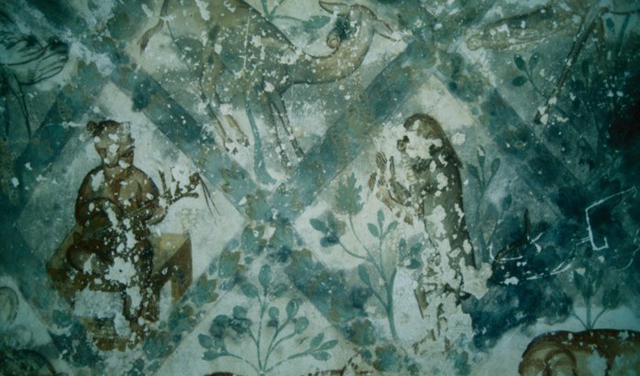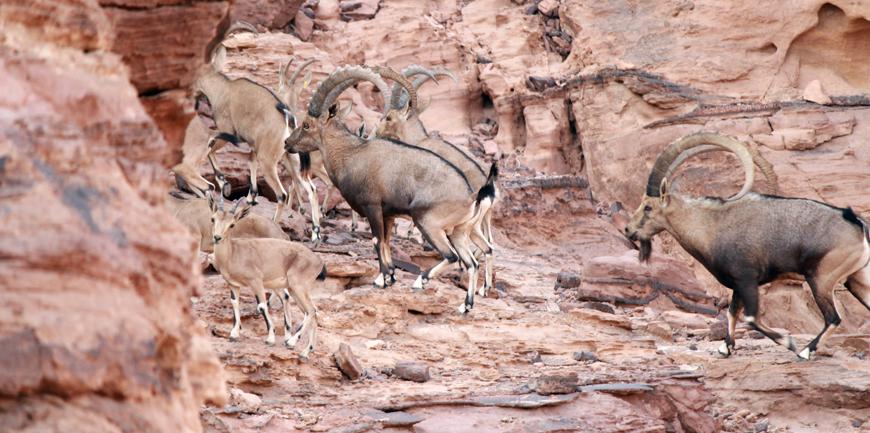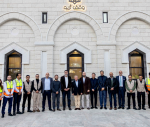You are here
Umayyad desert castles: Delving into Qusayr Amra’s carvings
By Saeb Rawashdeh - Mar 03,2024 - Last updated at Mar 03,2024

A fresco depicting a gazelle sniffing and a bear playing a lute in Qusayr Amra (Photo courtesy of ACOR)
AMMAN — Qusayr Amra is one of the so-called “desert castles” of the Umayyad period, situated in Wadi Al Butm, around 80km east of Amman. It was a royal retreat and the various structures included a reception room or hunting lodge and a bathhouse. A complex hunting cycle and different craftsmen were depicted on frescos and after the Abbasid shifted the centre of their realm towards Baghdad in Iraq, Qusayr Amra fell into decline.
The wallsand ceilings are thickly marked with soot from fires and the wall paintings are defaced by the impact of various projectiles, noted an Australian scholar, highlighting that the walls up to head height and more are covered with graffiti.
“Most of this comprises written texts, largely names, but on a recent visit, it was noticed that in a corner of the main chamber, a few animals had also been carved, said Alison Betts from The University of Sydney, adding that these overcut the fresco and thus date to sometime between the early Islamic period and the recent past.
Three types of animals can be identified, all apparently quadrupeds, three examples of which areclearly shown with horns, Betts said, noting that these latter examples are long in the body, with huge back-sweeping horns which extend over the rump.
“Horned animals native to Arabia include the Oryx, with long, straight horns, the ibex with backward curving horns and the gazelle with shorter horns. The Arabian Oryx is known to have existed wild in the Arabian Peninsula up until at least the late nineteenth century,” Betts said, adding that the ibex and the gazelle still exist in the wild in very low numbers.
The second type of carving is a smaller animal with either short horns or upright ears and a thin body. This may be either a goat or a gazelle or possibly a dog. Two examples have short tails curving back over the rump.
The third type, of which there is only one example, is much more schematised, and it is hard to distinguish any particular features apart from stick-like protuberances above and below the “body”, possibly indicating horns and legs, Betts continued, adding that it may not be the representation of an animal.
There is a tendency to assume that, unless directly associated with text, carvings of wild animals are likely to be prehistoric in date, Betts said, adding that the ibex/Oryx figure is very distinctive and the carvings are in the form of cartoons, which identify the key characteristics of the animal without any attempt at serious realism.
“This cartoon style is likely to have a long history and it may well have been used in prehistoric times as well as in the Islamic and later periods, while hunting as a sport and means of dietary supplement continued in Arabia up until the mid-twentieth century, essentially until there was nothing left to hunt,” Betts underlined, noting that in a field where both absolute and relative dating are virtually absent, the ‘Amra carvings at least serve as a note of caution to show that such carvings do not belong exclusively in the prehistoric periods
Related Articles
AMMAN — Qusayr Amra, located approximately 80 kilometres east of Amman, is one of the desert castles typical for the early Islamic per
AMMAN — “The question of why there are no gazelles represented in the petroglyphs [designs pecked into a stone surface] remains puzzling,” s
WADI RUM — Sixty ibexes were released to the wild last Thursday in Wadi Rum as part of Jordanian-Emirati cooperation under the Sheikh Mohamm



















